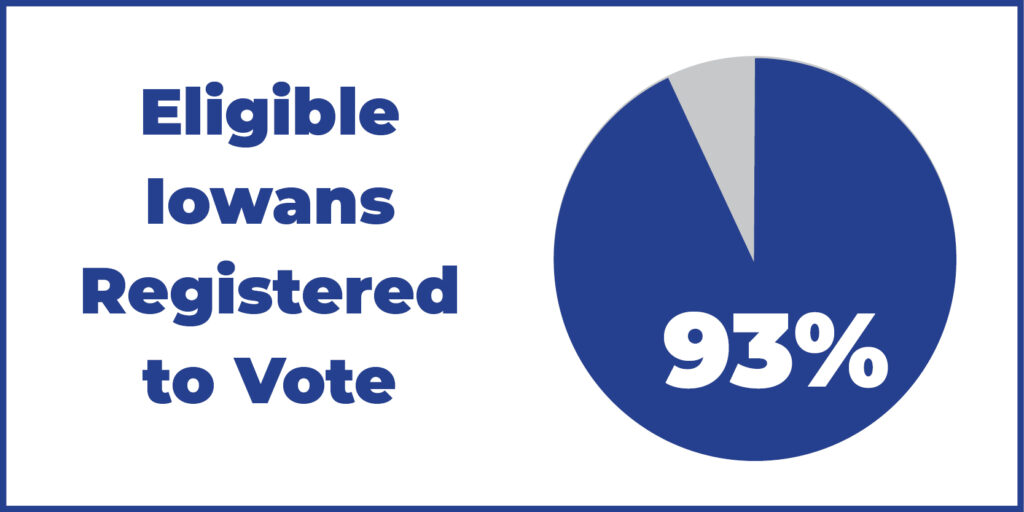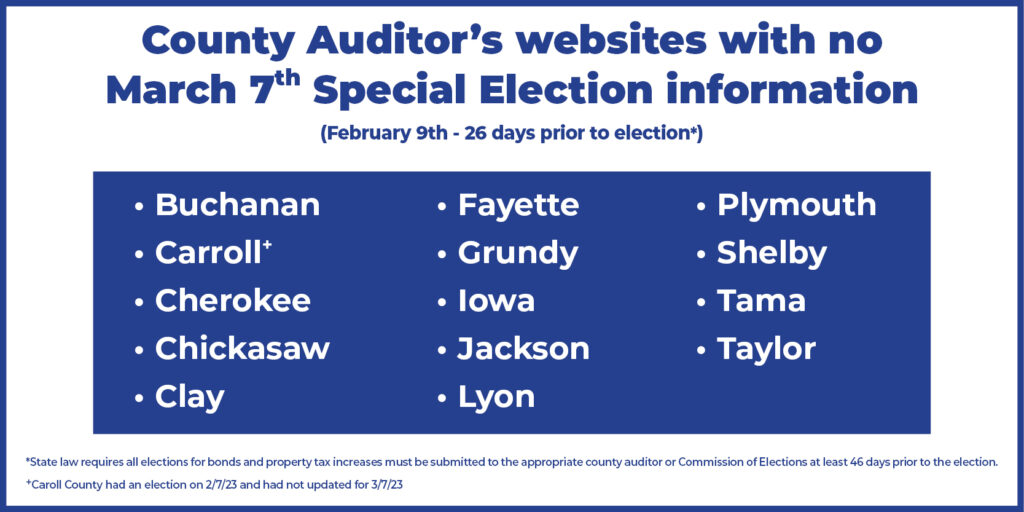At a time when property taxes are increasing across the state, requirements must be put into place to ensure Iowans have transparency on decisions about bonds and local tax increases.
Iowa has long been at the forefront of elections in the United States. Since the 1970s, both major political parties have held their caucuses in the state, and around 93% of eligible Iowans are currently registered to vote. Iowa is typically in the top 10 for voter registration and participation nationwide. Why, then, are election results in the state so often difficult to find, and why aren’t historical election data well categorized and accessible for reference, especially for local elections?

Reviewing the March 7, 2023, special election, in which multiple counties held bond referenda, provides the beginning of an answer to these questions.
Who Is Responsible for Local Elections?
The Office of Iowa’s Secretary of State, which also serves as the State Commissioner of Elections, is charged with reporting statewide election results. The Secretary of State’s mission is to “ensure election integrity and access to voting for Iowa citizens, and encourage Iowans to become civically engaged.” While the office’s website reports multiple statistics and data facts about Iowa elections, only information surrounding primary and general elections as well as special elections for state senate or representative seats is available. Other elections held across the state, such as school elections, bond referenda, and contests for local tax increases, are excluded.
Iowa permits special elections in March, September, and (in odd-numbered years) November. Those held to fill vacancies may be held on almost any Tuesday during the year. Keeping the results of these elections is the responsibility not of the Secretary of State, but of County Auditors. In 1972, the state legislature gave every County Auditor the additional title of “Commissioner of Elections.” In this role, auditors assumed the duties pertaining to all city, school, and special elections, which had previously been administered by each individual entity. In 1975, with the implementation of a statewide voter registration law, the auditors added “County Registrar of Voters” to their titled responsibilities, tasking them to maintain the current voter registration records.
What Is the Local Election Process?
The level of participation on March 7, 2023, showed that most Iowa citizens — who are well aware elections take place in November each year — don’t have the same level of awareness about the many special elections that may occur throughout the year. This reduced citizen engagement pairs with many County Auditors’ lack of resources or willingness to place a high priority on special elections and detailed reporting about them.
Under state law, entities holding elections for bonds and property tax increases must submit the relevant information to their County Auditors or Commissioner of Elections at least 46 days beforehand. Less than one month before the March 7 election, however, only 21 of the 35 counties holding bond referenda had information posted on their websites.

Pre-election inconsistency of information is followed by variations in post-election reporting. Some counties, such as Fayette, Johnson, and Story, report extensive detail on local elections, while other counties, like Grundy and Shelby, don’t have any election data on their websites at all. The information that is available has no uniform format because state law allows each auditor to report it as they see fit.
After an election, counties that report election results typically post unofficial numbers on the night of the election or the following morning. Some offer up-to-date reporting on their websites, while others choose social media as their means of communication.
On the Monday or Tuesday following an election, the county's Board of Supervisors must meet and canvass the returns from each voting precinct. By state requirement, these results are compiled into abstracts that each member of the board must sign and certify as correct. If an election crosses county lines (as is the case for many school districts), the “control county” must conduct a second-tier canvass and report the final results of the election. The control county is the one with the largest taxable base within the political subdivision.
For the March 7 elections, very few counties reported official results on their websites after the first canvass. Even fewer second-tier canvasses of final results were posted online. Because control counties are not named on the ballot or listed on county websites, finding results can be very difficult, especially when districts cross multiple county lines, as with community colleges.
Making matters worse, counties do not share voter turnout data with each other, only the abstracts certified by their county boards. The only way to find regional voter turnout data is to contact every entity and manually calculate the turnout. In some cases, the County Auditor does not have access to voter registration information for school districts that are partially within the county. Therefore, to calculate the registered voter figure for multiple school districts investigators must contact the Secretary of State’s office to access the statewide voter registration database, iVoters.
Why Is This a Problem?
Citizens, news outlets, and other interested parties cannot accurately track upcoming local elections or their results because of the irregularity in reporting, the lack of information, and the delayed posting of data. Without a uniform methodology for reporting election results, it is nearly impossible to find the statistics associated with contests that cross county lines, because the control counties may or may not include the other jurisdictions’ information.

The situation is so bad that the Department of Education, which used to report school bond results on its website, stopped the practice because the information was too difficult to obtain. Gaps in reporting also mean neither the Iowa State Association of Counties nor the Iowa League of Cities can track or inventory this information. Meanwhile, the Secretary of State’s website only handles general and primary elections, not financial questions such as those determining public debt and bonds.
At a time when property taxes are increasing across the state, Iowans must have transparency on decisions about bonds and local tax increases.
Policy Solutions
1. Require the Iowa Secretary of State to report and keep election statistics for all elections held in the state.
As the supervisor of elections, this office already conducts a statewide canvass of votes and certifies the results of Iowan and federal elections, including preliminary results on election night. Extending this action to local and special elections would reinforce the office’s mission to provide information and encourage engagement.
2. Require the Secretary of State to list and aggregate all upcoming contests well in advance.
To alert the public and to observe trends, news outlets and advocacy organizations must have accurate and timely information. This policy also aligns with the Secretary of State’s mission to encourage Iowans to become civically engaged.
3. Require County Auditors to report election information on their websites.
Information about upcoming elections as well as election results should be available in a consistent location. The Voter Registration Division within the Secretary of State’s office already oversees the activities of county election commissioners and prescribes uniform election practices, procedures, and forms required for the conduct of elections. Helping County Auditors with uniform reporting or website development to display information in an easy-to-use format would not be outside of the office’s scope.
4. Require County Auditors to post information about elections beforehand and after the results have come in.
If the Secretary of State aggregates this information, counties can easily provide residents with links on their websites — a common practice for federal and state elections.
